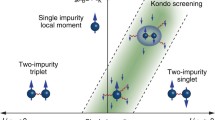The theory of the many-impurity Kondo system developed in a previous paper is coupled with a statistical model, using a phenomenological relationship between the magnetic susceptibility χ and the effective Kondo temperature, to obtain the magnetic susceptibility of a very dilute Kondo system well below the single-impurity Kondo temperature. We find that the magnetic susceptibility can be represented as arising from a single-impurity effect proportional to the impurity concentration c, another term proportional to c 2, as well as a much smaller c 3 contribution. The coefficient of the c 2 term in χ has an approximate Curie law behavior at sufficiently low temperatures. The detailed temperature and concentration dependence of χ is in very good quantitative agreement with experiment, and is the first theoretical explanation of the anomalous magnetic susceptibility for Cu-Fe below T K. The modification of the susceptibility arises in the theory from the inhibition of the spin-compensated state by the impurity-impurity interaction. The latter renormalizes the ln T term even in the region of temperature where the system is magnetically completely disordered.
Similar content being viewed by others
References
J. Kondo, Progr. Theor. Phys. (Kyoto) 16, 45 (1964).
E. C. Hirschkoff, M. R. Shanaberger, O. G. Symco, and J. C. Wheatley, J. Low Temp. Phys. 5, 545 (1971); 5, 155 (1971).
J. L. Tholence and R. Tournier, Phys. Rev. Lett. 25, 867 (1970).
J. Souletie and R. Tournier, J. Phys. (Paris) 32, C2–172 (1971).
H. E. Ekstrom and H. P. Myers, Phys. Kondens. Materie 14, 265 (1974).
Y. C. Tsay and M. W. Klein, Phys. Rev. B 7, 352 (1973).
Y. C. Tsay and M. W. Klein, Phys. Rev. B 11, 318 (1975).
M. W. Klein, Y. C. Tsay, and L. Shen, in Proc. 13th Int. Conf. Low Temp. Phys., Boulder, Colorado, 1972 (Plenum, New York, 1974), Vol. 2, p. 470.
K. Matho and M. T. Beal-Monod, Phys. Rev. B 5, 1899 (1972).
H. Suhl, Solid Slate Comm. 4, 487 (1966).
M. A. Ruderman and C. Kittel, Phys. Rev. 96, 99 (1954).
T. Kasuya, Progr. Theor. Phys. (Kyoto) 16, 45 (1956).
K. Yosida, Phys. Rev. 106, 896 (1957).
H. Margenau, Phys. Rev. 48, 755 (1935).
P. W. Anderson, Bell Telephone Laboratory Preprint, 1960.
M. W. Klein, Phys. Rev. 173, 552 (1968); 188, 933 (1969).
I. S. Gradshtein and I. M. Ryshik, Table of Integrals, Series, and Products (Academic Press, New York, 1966).
K. D. Shotte, Phys. Rev. B, 2228 (1971).
K. G. Wilson, Cornell University, Preprint.
A. I. Larkin, V. I. Mel'nikov, and D. E. Khmel'nitzky, Soviet Phys.—JETP 33, 458 (1971).
W. Marshall, Phys. Rev. 118, 1520 (1960).
Author information
Authors and Affiliations
Additional information
Part of this work was supported by USAFOR, under contract 73-2430 during a summer visit at Yeshiva University.
Rights and permissions
About this article
Cite this article
Klein, M.W., Shen, L. & Tsay, Y.C. Many-impurity effects in a weakly interacting Kondo system: Comparison of theory with experiment. J Low Temp Phys 19, 433–447 (1975). https://doi.org/10.1007/BF00114091
Received:
Issue Date:
DOI: https://doi.org/10.1007/BF00114091



